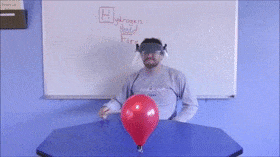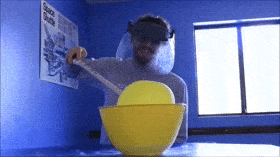
Can you change the speed of a reaction just by changing the temperature? That’s what we’re going to find out! First, we need to understand the reaction:
This balloon is filled with hydrogen, and then it is lit on fire. This is known as a combustion reaction, where hydrogen combines with oxygen. This means that the result of this fireball is actually….H2O, or water vapor! In chemistry, we would write this equation like this:
2 H2 + O2 → H2O + Heat
While heat may not be a molecule, it is a very important part of the reaction. This all has to do with energy. While hydrogen and oxygen are stable molecules, they store more energy than water. Nature tends to push towards having molecules in the lowest available energy scenario. That seems to mean that hydrogen and oxygen should always be combining and wood should always be on fire (since if fire gives off heat, the result of fire has to be lower energy than the wood), but fortunately this isn’t what actually happens! This is because of the graph below:
The curvy red line shows what the energy looks like throughout the reaction. The reactants, as noted above, have higher energy, and the products have lower energy, and the difference between them is the heat. There is also the weird little bump, which is known as activation energy. For the reaction to start at all, some energy needs to be added, which is why we have to light a fire. Touching the lighter to the balloon supplies enough heat to start the chain reaction of combustion of all of the hydrogen.
The hydrogen in the balloon is about 70℉. What happens if we change that temperature? What does temperature mean and why should it matter? When we measure how hot something is, what we are really measuring is how fast the atoms and molecules are moving. For the hydrogen to react with oxygen, it has to be close enough to the oxygen and have heat to start the reaction. Adding liquid nitrogen to the situation cools it down by about 400℉, to -321℉. You can see this immediately by the size of the balloon. It appears to crumple under the weight of the liquid nitrogen, but really the gas inside is just slowing down so much that it can’t push out the sides of the balloon. With the molecules slowed down, the reaction should slow down too! Here they are side by side:

If it looks like the one on the right has been slowed down, it has…by the dramatic change in temperature of the reaction! This may seem exotic, but there are practical examples of this. Refrigerators are used to keep the temperature of your food low to slow down spoiling. Lizards and other ectotherms move more slowly in cold weather as they lack a way to keep up their body temperatures.




